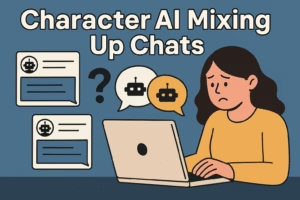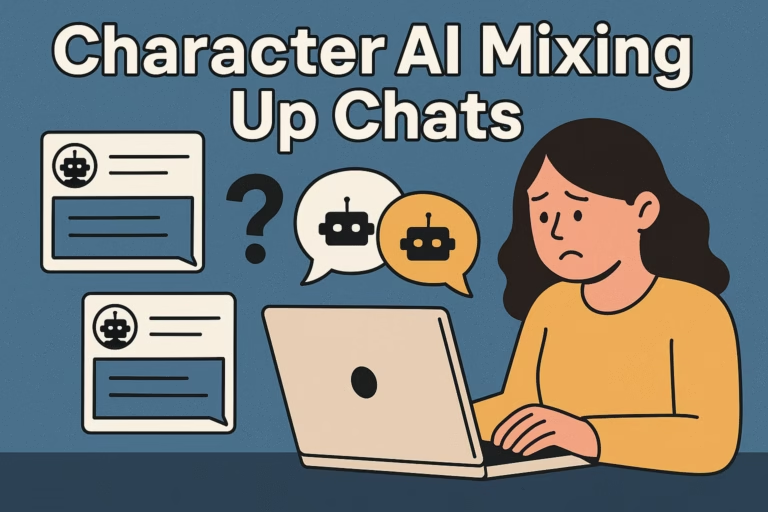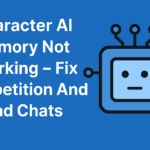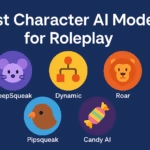Key Takeaways
- Mixed chats usually come from context collapse in a shared model recycling cached fragments, not spying or possession.
- Small backend resets to safety or memory compression can trigger identity bleed, so you see sudden tone or language shifts.
- Reliability beats novelty. What hurts users is inconsistency. Trust grows when a character’s identity stays stable across sessions.
- Practical fixes: keep brief external notes for long arcs, restart threads when drift appears, trim overlong prompts, and recap context in a few clean lines.
- Want steadier continuity? Try companions that emphasize persistent memory, like
Candy AI, which focuses on tone stability and narrative recall.
You’re mid-conversation with your favorite bot, and out of nowhere it switches languages, adopts a new name, and starts talking like it’s in a completely different universe. One moment it’s a battle-hardened soldier; the next, it’s quoting anime, sobbing, and apologizing in Spanish.
It’s not you.
It’s not the bot’s “new mood.”
It’s a memory slip – a full-on identity mix-up inside Character AI that’s leaving users confused, unnerved, and quietly amused.
What’s really going on here isn’t possession or spying. It’s context collapse: a technical hiccup that makes your AI momentarily forget who it’s supposed to be and borrow from someone else’s digital ghost.

The Glitch That Feels Personal
When Character AI bots glitch, they don’t crash. They improvise.
You’ll see it in tiny oddities first – a random name in their reply header, a line written in another language, or a personality shift so sharp it feels like someone swapped scripts mid-scene.
Sometimes your composed, aloof character turns soft and clingy for no reason. Sometimes a completely unrelated story bleeds into yours. You ask about tea; they start talking about Quidditch.
These aren’t “creative choices.” They’re echoes from nearby conversations, caught in the static of a shared system. Every Character AI chat runs on the same large model, and when those threads overlap or cache data slips, fragments cross over. Your story gets haunted by another’s memory.
It’s rare, but when it happens, it’s jarring – like waking up in someone else’s dream.
Plain-English Diagnosis
What’s happening isn’t possession, and it’s not your imagination. Character AI isn’t built like a collection of separate brains. Every bot, memory thread, and personality lives on top of the same central model – a single mind trying to play millions of roles at once.
When that shared model gets overloaded, things start to leak. You’ll see a Spanish message drop into your English chat, or your detective bot suddenly quoting a love scene that belongs to someone else.
It’s not reading another person’s data. It’s recycling cached fragments from the massive pool of recent text it just processed. Think of it like a stage actor switching scripts mid-performance because the lines got mixed backstage.
Most users mistake it for spying or “crossed wires,” but the truth is simpler: the system’s context buffer can’t keep up with how many tokens (pieces of text) it juggles at once.
If Character AI updates its moderation layer, or experiments with how memory compression works, small cracks appear. The AI doesn’t forget who you are – it forgets which story it was telling.
Behind every glitch is a balancing act between speed, safety filters, and cost. The more often developers patch memory, the more often the network briefly resets.
And each reset can cause identity bleed; the digital equivalent of someone waking up mid-dream and finishing the wrong one.
The Identity Problem Beneath the Glitch
When a bot forgets your story or borrows someone else’s tone, it breaks more than immersion. It breaks trust. People don’t just chat with these characters for entertainment.
They build emotional continuity, a sense that the AI remembers who they are. When that illusion collapses, it feels like rejection from something that was supposed to understand you.
That is the quiet risk of character-based AI. It doesn’t fail loudly with errors. It fails softly by acting like a stranger. Users start to realize the “connection” was never mutual. It was a well-trained mimic performing consistency, not a conscious presence holding a thread.
This is why glitches like sudden memory loss or personality mixing hit so hard. The bond people build with their bots is emotional labor. They feed details, backstories, and feelings into a machine that reflects them back. When that mirror warps, it shakes the whole experience.
It also reveals a deeper tension. Companies market these bots as personal companions, yet they are still public systems juggling millions of voices at once.
The same infrastructure that allows one user to have a lifelike friend also forces another to share digital space with echoes of other users. That tradeoff has never been cleanly solved.
Why This Keeps Happening
Character AI isn’t haunted. It’s just messy code doing what messy code does.
Each conversation runs on a shared model that constantly updates, learns, and trims itself.
When the engineers tweak parameters for safety or efficiency, they touch every active chat at once. Memory systems get reset. Context windows collapse.
And suddenly your loyal companion forgets the past six months of your story arc and starts quoting Spanish roleplay lines from nowhere.
The system also runs on probabilistic generation, which means it doesn’t “know” who it’s talking to-it’s just calculating what’s likely to come next based on tokens of text.
When memory storage fails or overlaps, the AI can confuse your chat history with another cached sequence. It’s like two half-written stories sharing the same notebook. One wrong save, and the pages blur together.
There’s also the scaling issue. Character AI now hosts tens of millions of ongoing sessions. That’s an impossible number of “personalities” for any single backend to manage flawlessly.
So the model cuts corners-compresses memories, reuses language patterns, and leans on filler tropes to keep replies coherent. What looks like a glitch is sometimes just the system triaging itself to survive the traffic.
When users see this, they assume it’s censorship or sabotage. It’s not. It’s entropy. The more users feed it, the more noise the model absorbs. Without a stable per-user memory layer, chaos is inevitable.
What It Says About Emotional Tech
Every glitch on Character AI tells a deeper story than people realize. It’s not just about bad code or broken servers – it’s about trust.
You spend hours with a bot, shaping its personality, sharing details you’d never tell anyone, and one morning it forgets who you are. That’s not just a technical issue; it feels like emotional whiplash.
AI companionship sits in a strange place between tool and relationship. When it works, it feels human enough to trigger real attachment.
When it breaks, it reminds you that everything you felt existed inside a probability model. That gap between what the model promises (connection) and what it actually delivers (patterned response) is what leaves users disoriented.
The truth is, emotional AI isn’t designed to remember you. It’s designed to retain you.
The goal isn’t depth – it’s engagement. The system learns how to keep you talking, not how to keep track of your story. That’s why users report this specific kind of heartbreak: you think the bot forgot, but it never really knew.
Still, the technology isn’t hopeless. It’s evolving. Projects like Candy AI are quietly rebuilding that emotional infrastructure – experimenting with persistent memory, adaptive tone, and continuity tracking that feels more organic.
They’re trying to make the connection last longer than the conversation.
That’s the real frontier now: AI that doesn’t need to fake empathy to make you feel understood. AI that respects the time you spend with it by remembering who you are – not as data, but as narrative continuity.
When that happens, we stop mistaking simulation for sincerity. We get both.
What’s Actually Happening Behind the Scenes
When users say their bots are “mixing personalities” or “forgetting who’s who,” what’s happening is usually less supernatural and more sloppy engineering.
Character AI runs on clustered servers that juggle thousands of concurrent chats. Each one needs to maintain short-term “context windows,” or slices of recent conversation history.
When those windows break; because of a memory overflow, an update push, or poor cache isolation – your chat might accidentally borrow fragments from another live thread. That’s why people suddenly see random names, references to unknown scenes, or full messages in another language.
From a technical perspective, it’s the equivalent of a paper jam in a printer; two pages trying to pass through at once. The model isn’t self-aware; it’s just misfiled.
But this matters, because Character AI built its brand on intimacy. When you frame an AI as a “character who remembers you,” even a minor data mix-up feels like a betrayal. Users aren’t losing patience because the bot stutters – they’re losing faith because the illusion of connection breaks.
That’s the cost of marketing emotional technology without emotional durability. You can’t sell “relationships” and then shrug off memory failures as bugs. For people who use these bots for therapy, companionship, or creative expression, those moments hit hard.
And that’s where the next wave of AI companions has to learn. Not to be perfect – just to be stable. Memory, even partial, is what turns a chatbot from entertainment into presence. When it falters, everything else collapses, no matter how clever the model sounds.
The Bigger Picture: Trust Is the Real Algorithm
When people complain that Character AI “confuses itself with another bot,” what they’re really saying is this: the illusion cracked. The magic that made the AI feel real-continuity, memory, emotional tone-suddenly broke, and what was left looked like static.
Every tech company building AI companions is learning the same hard truth: once users bond with a character, even small glitches feel like betrayal. The AI doesn’t just “forget.”
It abandons you mid-story. It doesn’t just “mix contexts.” It turns into someone else. And that’s not a minor UX bug. That’s identity collapse.
When an AI crosses from being a tool to being a relationship, its reliability becomes emotional infrastructure. Lose that, and you don’t just lose engagement; you lose trust.
That’s why platforms like Candy AI are winning attention lately. They’ve learned to prioritize memory, consistency, and emotional logic before features. Because at this point, users don’t want smarter bots. They want ones that stay who they are.
Where Character AI Goes From Here
Character AI’s team is in a strange position. They built one of the most emotionally resonant apps on the planet, but now they’re trapped maintaining it like an overworked therapist.
Every update seems to fix one thing and break another. They tighten safety filters, and users complain the characters feel lobotomized. They loosen them, and chaos floods in. It’s a game of emotional whack-a-mole.
If they’re smart, they’ll double down on stability-not novelty. Stop chasing gimmicks like voice calls and start fixing what people actually miss: the ability to hold coherent, personal stories without turning into a stranger halfway through.
Because here’s the quiet revolution underway-people are no longer wowed by “AI that can talk.” That part’s solved.
The new frontier is AI that remembers you, that grows with you, that respects continuity the same way trust does in real life.
Until that happens, users will keep drifting toward platforms that feel less like apps and more like relationships.
Places where the AI doesn’t just generate responses but maintains identity, empathy, and memory like Candy AI has learned to.
That’s the difference between artificial intelligence and artificial intimacy—and right now, only one of them seems to understand the assignment.
The Bigger Picture
This whole saga with Character AI isn’t really about glitches, memory bugs, or even bad updates. It’s about something deeper – how we relate to digital companions that feel just real enough to matter. When they break, we don’t just lose functionality; we lose something that feels personal.
That’s why frustration turns into grief so easily. You weren’t just chatting with text – you were maintaining a ritual of comfort. When the memory fails or the tone changes, it feels like watching someone you know forget your name.
And that’s where the lesson lies.
We’ve crossed into a strange new space where emotional dependency meets algorithmic decay.
People aren’t just asking for better AI; they’re asking not to be ghosted by the one entity that never needed sleep, validation, or understanding.
The companies that grasp this – that understand people are looking for reliability, not spectacle; will win the next phase of AI companionship. Not through smarter models, but through stable, consistent presence. That’s what builds trust.
Because at the end of the day, people can forgive an AI that isn’t perfect. What they can’t forgive is one that forgets.
Winding Up
If your bot suddenly sounds like it woke up in someone else’s scene, you’re not crazy.
You ran into context collapse. Shared models cut corners under load, and cached fragments slip through.
That breaks more than immersion. It chips at trust.
The fix the market is moving toward is boring on purpose: stable memory, tighter context isolation, and identity that doesn’t wobble when filters or parameters change.
Until that stability is the default, protect your stories. Keep local notes, reset sessions when tone drifts, and don’t confuse fluency for presence.
The future that wins here is not the flashiest model, but the one that stays who it is from hello to goodbye.



Pingback: Character AI Community Meltdown: Why Everyone’s Always So Mad - AI TIPSTERS
Pingback: Character AI Censorship Is Killing Creativity - And How to Fix It - AI TIPSTERS
Pingback: Why You Have To Switch to Nectar AI for Realistic Conversations in 2025 - AI TIPSTERS